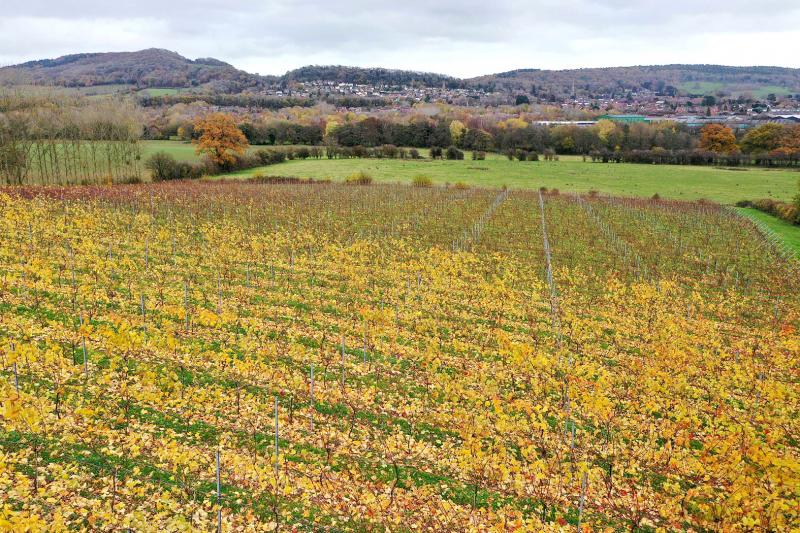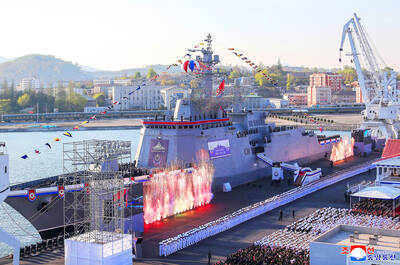In years gone by, British wine merchants would race to secure Beaujolais Nouveau for their stocks.
However, now the UK’s first young red is being made near the English border with Wales.
“It’s not a wine to be taken too seriously, it’s a fun drink, taking on the spirit of Beaujolais Nouveau,” winemaker Simon Day said at his vineyard in Ledbury, near Hereford.

Photo: AFP
Amid the gloomy atmosphere around the country during the COVID-19 pandemic, he said he hoped the wine would be a “little ray of sunshine to end the year.”
As is tradition, the “English Nouveau,” like its more famous French namesake, would be released on the third Thursday of November.
On the nose, the Herefordshire red has aromas of cherry, blackberry and cranberry as well as exotic fruits, Day said.
He recalled how at the end of the 1970s and in the early 1980s, British wine merchants competed to be the first to bring back Beaujolais Nouveau directly from the producers.
They returned from France “driving as fast as they could” in sports cars filled with cases of wine, he told reporters.
“It was a big event. Lots of press, lots of media, lots of fun,” the winemaker said, adding that he hoped good English red wine could be similarly celebrated.
The 2020 vintage from the Herefordshire vineyard is Day’s second after the winemaker became the first to produce a primeur red wine in the UK.
The whole production would amount to 2,500 bottles and would be sold in the upmarket supermarket chain Waitrose for £11.99 (US$15.79) a bottle.
The price is more expensive than Beaujolais Nouveau, most of which sells for between 5 euros and 10 euros (US$5.94 and US$11.88) in France.
Instead of the traditional variety of Gamay grape used in Beaujolais, the English winemaker uses Pinot Noir.
Otherwise, the winemaking process remains the same, using carbonic maceration to extract flavor and color from the grape without an overbearing taste of tannin.
Space is increasingly being given over to vineyards in Herefordshire, predominantly at the expense of orchards for apple-growing, which has become less profitable.
Last year, the UK had 3,500 hectares of vineyards — four times the space devoted to vines in 2000.
In the past 10 years, the land used for vineyards has increased 150 percent, Wine GB, the UK’s professional winegrowing association, estimated.
There are 770 vineyards in the UK, nearly three-quarters (72 percent) of which produce sparkling wines.
Day said global warming is a factor in the growth of British winemaking.
As one of the country’s few second-generation winemakers, he has observed that harvesting takes place, on average, two to three weeks earlier than it did at the start of his career.
At the very start of the UK’s wine revival in the 1970s, Day’s father made wine just “a stone’s throw” away from where he now works.
“Despite my parents’ best efforts to make me find a proper job, the lure of wine had me in its grasp, I really wanted to make wine,” he said.
He worked in Australia, the US and even France before returning to Ledbury, a historic market town halfway between Worcester and Hereford in the shadow of the spectacular Malvern Hills.
His vineyard has the advantage, compared with others in the area, of being spared rain coming from the west, creating what Day described as a “relatively dry climate.”
The soil also allows the vines to dig their roots deep into the earth.
Winemaking in the area of south-central England, which has a long-standing reputation for cider, can trace its origins back much further than a couple of generations.
Writings dating back to 1276 from the Bishop of Hereford contained orders to plant vines on the slopes nearby.
There are also indications that wine from the vineyards was sent to the pope at the time.
“So it was already exported back then,” Day said.
Today, 90 percent of English wines are sold locally, but also in Scandinavia, North America and Australia.

Archeologists in Peru on Thursday said they found the 5,000-year-old remains of a noblewoman at the sacred city of Caral, revealing the important role played by women in the oldest center of civilization in the Americas. “What has been discovered corresponds to a woman who apparently had elevated status, an elite woman,” archeologist David Palomino said. The mummy was found in Aspero, a sacred site within the city of Caral that was a garbage dump for more than 30 years until becoming an archeological site in the 1990s. Palomino said the carefully preserved remains, dating to 3,000BC, contained skin, part of the

TRUMP EFFECT: The win capped one of the most dramatic turnarounds in Canadian political history after the Conservatives had led the Liberals by more than 20 points Canadian Prime Minister Mark Carney yesterday pledged to win US President Donald Trump’s trade war after winning Canada’s election and leading his Liberal Party to another term in power. Following a campaign dominated by Trump’s tariffs and annexation threats, Carney promised to chart “a new path forward” in a world “fundamentally changed” by a US that is newly hostile to free trade. “We are over the shock of the American betrayal, but we should never forget the lessons,” said Carney, who led the central banks of Canada and the UK before entering politics earlier this year. “We will win this trade war and

‘BODIES EVERYWHERE’: The incident occurred at a Filipino festival celebrating an anti-colonial leader, with the driver described as a ‘lone suspect’ known to police Canadian police arrested a man on Saturday after a car plowed into a street party in the western Canadian city of Vancouver, killing a number of people. Authorities said the incident happened shortly after 8pm in Vancouver’s Sunset on Fraser neighborhood as members of the Filipino community gathered to celebrate Lapu Lapu Day. The festival, which commemorates a Filipino anti-colonial leader from the 16th century, falls this year on the weekend before Canada’s election. A 30-year-old local man was arrested at the scene, Vancouver police wrote on X. The driver was a “lone suspect” known to police, a police spokesperson told journalists at the

North Korean leader Kim Jong-un has unveiled a new naval destroyer, claiming it as a significant advancement toward his goal of expanding the operational range and preemptive strike capabilities of his nuclear-armed military, state media said yesterday. North Korea’s state-run Korean Central News Agency (KCNA) said Kim attended the launching ceremony for the 5,000-tonne warship on Friday at the western port of Nampo. Kim framed the arms buildup as a response to perceived threats from the US and its allies in Asia, who have been expanding joint military exercises amid rising tensions over the North’s nuclear program. He added that the acquisition